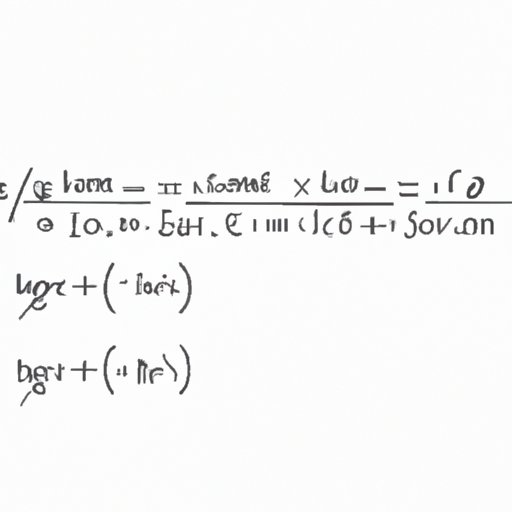
Introduction
Linear equations are an essential tool in mathematics, used to describe the relationship between two variables. One of the most common forms of a linear equation is y = mx + b, where ‘m’ represents the slope and ‘b’ represents the y-intercept. While finding the slope may seem relatively straightforward, finding the y-intercept, or ‘B,’ can sometimes feel like a mystery. In this article, we will delve into the specifics of finding ‘B’ in a linear equation.
Solving for y-intercept in a Straight Line Equation: Understanding the ‘B’ in y = mx + b
Before we dive into how to find ‘B,’ it’s important to understand what ‘B’ represents in a linear equation. The y-intercept is the point where the line crosses the y-axis, and it determines the starting point of the line. In the equation y = mx + b, ‘m’ represents the slope or the rate of change, and ‘b’ represents the y-intercept or the initial value.
When graphed, the slope and y-intercept can tell us a lot about the relationship between the two variables. The slope tells us the direction and steepness of the line, while the y-intercept gives us the starting point. For example, if we have the equation y = 2x + 3, we know that the line will have a slope of 2, meaning for every unit increase in X, the value of Y will increase by 2. We also know that the line will intersect the Y-axis at the point (0, 3).
The Key to Solving Linear Equations: A Step by Step Guide to Finding ‘B’ in y = mx + b
Now that we’ve established what ‘B’ is and its function in a linear equation, let’s explore how to find ‘B’ when given a straight line equation.
Step 1: Identify the values for ‘m’ and ‘x’
Begin by identifying the given slope, ‘m,’ and choosing a specific value for ‘x.’
Step 2: Identify a point on the line
Choose a point on the line that corresponds to the value chosen for ‘x.’ For ease of calculation, it’s best to choose points on the line that correspond to x-intercepts or whole numbered points.
Step 3: Plug in values for ‘m,’ ‘x,’ and the corresponding point
Using the values identified in steps 1 and 2, plug them into the equation y = mx + b and solve for ‘b.’
Step 4: Solve for ‘b’
Arrange the equation to isolate ‘b’, which yields the value of the y-intercept.
Let’s take the equation y = 2x + 3 as an example. If we choose the value of x to be 2, we can identify the point on the line as (2, 7). Substituting these values in the equation gives us 7 = 2(2) + b. Then, rearranging the equation to isolate ‘b’ results in b = 3. Therefore, the y-intercept is 3.
Busting the Myth: ‘B’ in y = mx + b is Not As Complicated As You Thought
Despite its importance in a linear equation, many people find it intimidating to find the y-intercept, or ‘B.’ Common misconceptions include believing that ‘B’ is always negative, or that it is the value of ‘y’ when ‘x’ is zero. In actuality, the value of ‘B’ can be positive, negative, or zero, depending on the line’s equation and its representation on a graph.
Finding ‘B’ may seem challenging at first, but with practice, it can become easier. As you work through problems, you’ll begin to develop a better understanding of how the slope and y-intercept work together to create a line.
Additionally, there are many resources available to help you practice and improve your skills in linear equations. Online tutorials, practice problems, and textbooks are just a few examples. Don’t be afraid to seek out extra help if needed.
From Slope to Intercept: Uncovering the Mystery of ‘B’ in y = mx + b
While we’ve emphasized the importance of finding ‘B,’ it’s essential to understand how the y-intercept fits in among slope and other important factors. The slope, represented by ‘m,’ provides information about the direction and steepness of the line while the y-intercept, ‘B,’ gives us the line’s starting point.
When using linear equations in real-world scenarios, it can help to understand how to use ‘B’ to find other values. For example, suppose you’re using a linear equation to determine the cost of a product. In that case, you may know that the ‘B’ value represents the initial cost of producing said product.
Mastering Linear Equations in One Lesson: How to Find ‘B’ in y = mx + b
In summary, finding ‘B’ in a linear equation is crucial in understanding the relationship between two variables. By following the step-by-step guidelines and practicing regularly, you can begin to understand how to find the y-intercept quickly. It’s also important to note that misconceptions surrounding ‘B’ are abundant and to seek out extra resources to improve your understanding.
Whether you’re a student or working professional, mastering linear equations can improve your analytical skills and provide useful tools in real-world applications. By uncovering the mystery of ‘B’ in y = mx + b, you’re well on your way to becoming a master in linear equations.
Conclusion
In this article, we’ve broken down the steps to finding ‘B’ in a straight line equation. We’ve also addressed some of the common misconceptions surrounding ‘B’ and provided tips for practicing and improving your skills. Remember that finding ‘B’ is an essential aspect of understanding linear equations and how variables interact. By applying what you’ve learned and practicing regularly, you can develop a deeper understanding of linear equations and their real-world applications.




